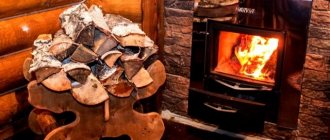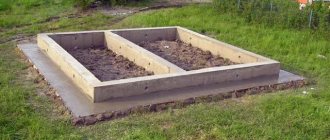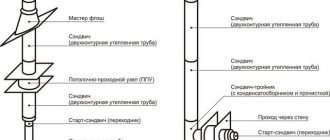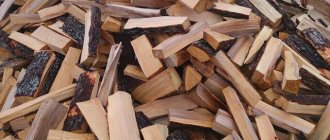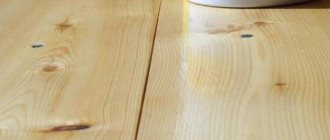Original design of a Finnish sauna
Warm greetings to all readers!
Today there are many types and designs of baths. Historically, the following types have developed - Roman, Eastern, Irish, Japanese, Finnish and of course Russian. Modern pundits distinguish the following types of baths and saunas:
- — Russian (high humidity bath);
- — Roman (dry with different temperatures in different rooms);
- — Sauna – Finnish bath (very hot with dry air).
With this division, Russian and Finnish baths are practically antipodes. In fact, the original Russian bathhouse was dry. A real village bathhouse is usually equipped with such a powerful stove that obtaining high-temperature dry steam is not difficult. There is also the following division of baths into types:
- Heater sauna (Russian or Finnish) with temperatures up to 120 degrees and humidity 5-20%;
- Steam, with a humidity of 75-100% and a temperature of 60-70 degrees;
- Water, according to the Japanese principle, with a temperature of 50-60 degrees.
To this division of baths by type, it is worth adding Turkish baths. Most likely, their prototype was one natural hot spring. The Russian and Finnish baths have a different origin - hot stones on which water splashed.
Classification of baths by microclimate
By and large, all baths can be divided into three main groups:
- Steam with minimal heating - characterized by soft heating up to +45-50⁰С and high humidity, which reaches 100%. In such a microclimate, the body does not experience overload; detoxification and cleansing occurs not due to high temperatures, but due to absolute humidity.
- Steam with medium heating - temperature within +50-60⁰С, with air humidity of 60-65%. At average temperatures and high humidity, a thin film of water from condensed steam forms on the skin, due to which the body warms up faster and deeper.
- Dry air - at temperatures of 100⁰С and above, humidity is minimal and is no more than 20%. High temperatures are necessary for deep heating, since dry air conducts heat worse than humid air. But many people tolerate elevated temperatures more easily than high humidity with average heating.
It is convenient that today there is no need to choose only one of the modes, since modern furnace equipment is universal and, if desired, you can get both hard dry burning and soft wet steam in the same bath.
Terme di Saturnia - Saturnia, Italy
0
Source:
As an old Roman myth says, during a stormy showdown, Jupiter threw lightning at Saturn. But Saturn dodged, and lightning struck the earth, breaking the earth's crust and creating a hot healing spring, known today as Terme di Saturnia, or "Saturn's Spa." This natural hot bath, located in a volcanic crater, has been attracting people for over a thousand years.
Method of heating and steam generation
To bring the bathhouse to the specified temperature and humidity conditions, two main methods are used.
- Direct heating - closed, open or combined heater stoves are installed directly in the steam room, although some solid fuel models can be heated from an adjacent room. Steam is generated by the stone mass, to which water is periodically supplied.
- Distributed heat - pipes are built into the walls, floors and sun loungers, through which heated water circulates, heating the surfaces. In the original version, steam from water boiling in the boiler circulated through pipes laid in the floor, and it was supplied to the steam room through holes in the walls. In the modern version, the coolant is heated by an electric or gas boiler, and the humidity is provided by a specialized steam generator.
In both the first and second options, as it heats up, not only the equipment, but also the walls become a heat source, and additional heating occurs due to convection. To provide heat to the washing room, modern baths often have a water-heated floor.
Baths of the world: a short excursion into the kingdom of water and steam
In one port city, famous for its humor, when asked: “which bathhouse is the best,” it is customary to answer: “the one that is closest to home.” However, serious experts in the field of bath technologies are still, without sparing themselves, fighting in heated debates, trying to identify the best and most useful bathhouse from the wide range that all bathhouses in the world represent. Maybe we should try it too?
Features of the Russian bath
The original Russian bathhouse is a log house with a stove, in which they steamed, washed, and delivered babies from generation to generation. In the modern version, the steam room and washing room are separated, and the stove can be not only brick, but also metal (with or without brick/stone lining). In a Russian steam bath, the temperature regime is average and humidity is high: tanks with boiling water are no longer relevant; steam in the required quantity and quality is obtained from stones.
The air in the steam room is heated unevenly, which is quite convenient - those who prefer a lower temperature are located on the lower shelves, and those who prefer “hotter” temperatures are located on the upper ones, under the ceiling.
And, of course, what is a Russian bathhouse without a broom, thanks to which there are not two, but three heat sources.
p9181848FORUMHOUSE Member
In a Russian bath, in addition to radiation from the stove and walls and convection, a fundamentally different method, effect and pleasure is added: heat transfer by condensation of hot steam on the “cold” body of the steamer. This method (moving steam with brooms from the ceiling to the body) gives the speed of warming up and the main tactile pleasure, for those who understand and know how.
Washing
The washroom is a very damp place. Therefore, experts recommend covering the walls, ceiling and floor with ceramic tiles or mosaics. Fortunately, there are tiles on the market that perfectly imitate wood structure. No? Do you want to enjoy the amazing beauty and sensual aroma of wood in every room of your bath or sauna? Well, what then? No problem.
You can decorate the washing room with the following types:
- luxurious teak;
- charming mahogany;
- noble abash.
These rocks are moisture resistant, but still require additional impregnation with special substances.
Luxurious teak
Teak, famous for its rich color palette, velvety surface and matte shine, is known for its excellent technical characteristics. For example, it is incredibly durable because it is biologically passive, chemically inert, moisture-resistant, and heat-resistant.
Due to the high content of certain natural oils, teak cladding has a beneficial effect on the human body. In addition, esotericists claim that the tree species has powerful energy. Teak is wonderful for covering all sink elements.
Charming mahogany
Mahogany is the wood of kings. She can't be demolished. She's not afraid of anything. This tree species is unaffected by climatic, chemical, thermal, mechanical and biological factors. In addition, it is incredibly beautiful and fragrant. Mahogany also has healing properties. In addition, it is famous for its light energy, which has a beneficial effect on a person. It is perfect for covering floors, ceilings and walls.
Noble Abash
Abash in nature
Abash is a guest from colorful Africa. It has an amazing texture and an exciting scent. In addition, it is not afraid of temperature changes, moisture, alkalis, acids, fungus, and shock. Abash is capable of serving faithfully for many decades.
In addition, due to its high content of nutrients, it calms the nervous system, saturates it with vitality and fights various diseases. Abash is also a tree that takes away negative energy and gives positive vibes. It is ideal for covering all elements of the sink.
Abash, mahogany, teak are species that, as practice shows, do not suffer from demolition, since they are not afraid of the harmful effects of negative environmental factors. However, their price is extremely impressive. So be prepared to part with a small fortune.
Features of the Finnish sauna
Although there is an opinion that the Finns themselves are not at all opposed to giving in to the parka and waving a broom, the saunas that have spread throughout the world with their light hand are dry-air saunas. The humidity in them is minimal, the temperatures are extreme, and people steam mainly while sitting. The air warms up evenly and there is no such difference between the temperature on the bottom shelf and on the top, as in a Russian bath. Due to the sitting position, steam rooms are characterized by compact dimensions and a compact metal stove with an open heater. And since it is not necessary to pour water over the stones to create steam in saunas, the stoves can also be electric, which do not need to be heated, just set the appropriate mode. Saunas are often not separate buildings, but rooms directly in the house, since minimal humidity does not create any special problems when arranging a wall “pie”.
Whether in a bathhouse or a sauna, the effect depends not only on the microclimate in the steam room, but also on the “extras”.
p9181848FORUMHOUSE Member
The most important detail of a proper bath: a barrel, a font, or better yet, a pool, albeit a small one, for example, 150x200 cm, with a depth of 100 cm. After all, it is the consistent change in temperature when immersed in cold water that gives the main healing effect of the bath: temporary vigor; real euphoria (release of internal endorphins and serotonin); resulting long-term boost in immunity.
Takaragawa Onsen - Minakawa, Japan
0
Source:
Takanagawa Onsen in the village of Minakami, Gunma Prefecture on the island of Honshu is perhaps the most picturesque spa complex in Japan. For a country where there are many hot springs and a cult of natural beauty, this says a lot. Locals claim that the waters of the hot spring in Minakami have magical healing powers. Therefore, people have been coming here to be treated with hot waters since ancient times. The spa has three general baths and one separate one for women.
Features of the Turkish Hammam
A steam bath with minimal temperatures and absolute humidity is a Turkish hammam, although the Turks borrowed the idea from the Romans, but added a distinctive oriental flavor to the baths. If the Russian bathhouse and sauna are quite similar, and in one steam room you can enjoy both steam and dry air with alternating success, the hammam stands apart.
In a bathhouse/sauna, the air is first heated, giving off heat to the surfaces; in a hammam, on the contrary, the surfaces are heated (distributed heat), from which the air warms up.
And the surfaces themselves are not wooden, but exclusively stone and its derivatives, and this is due not only to the East’s craving for luxury, but also to the high thermal conductivity of the material. In its original form, the hammam includes a dressing room and five steam rooms with different temperature conditions, as well as several pools with warm and cold water. The version adapted by private owners differs from a regular bathhouse only in the specific steam room without a stove and in tiles.
Japanese
There are two types of Japanese baths: furo - private at home, and sento - public.
This vessel was heated to a temperature of 40-50 degrees, in which a bench was also installed to make it more convenient to sit in it.
A person immersed in water had to ensure that the water did not reach the level of the heart. The bathing procedure usually does not take more than 10-15 minutes.
The water in this pool is constantly changing, and the temperature reaches 50 degrees. Before diving into this large pool, they first wash in special rooms.
After the steam room, they relax in the rooms designated for this.
Steam room
To decorate the steam room, you need to use only hardwood, otherwise resin will be released, which will stick to the body.
Suitable tree species include:
- Linden;
- aspen;
Finishing the steam room with aspen
- alder;
- larch;
Larch steam room
- Abashi tree.
The floor does not have to be wooden; it can be made of tiles (non-slip), stone tiles.
From a hygiene point of view, it is better to use tiles, since a wooden floor sooner or later turns black and dirty.
Tiled floor in the sauna
There are no special requirements for the design of the steam room: this place is designed in the spirit of minimalism, since the tree itself already remarkably transforms the room.
To add some variety and dynamics to the steam room, you can make multi-level sun loungers, put out wooden buckets, lay out brooms, and hang ladles on the walls. A great way to save space is to arrange corner sun loungers. You can also leave a window inside the steam room; it will hide the closedness of the room and also serve as ventilation.
Corner loungers will save sauna space
Termas Geometricas - Pucon, Chile
0
Source:
Termas Geometricas is one of the world's largest natural thermal baths, located in the Villarica National Park in Chile. Long red wooden walkways connect 20 hot tubs located on the canyon floor and surrounded by lush vegetation. Termas Geometricas also has two waterfalls that are used as cooling baths after a dip in the hot springs.
Where to begin
It will be necessary to decide how many people the sauna is intended for. If for one or two, then a sauna cabin will be quite enough, but if you plan to receive guests or spend time there with family and friends, then you will need a larger area, and you will also need to arrange a place to relax.
Home sauna for two people
Now you can buy a ready-made cabin, and make it yourself, choosing any finish you like, the main thing is to decide on the requirements, design, and optional features of the sauna.
